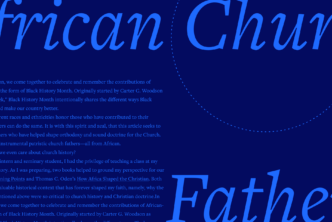What does “Pentecostal” mean? The word comes from the Greek πεντηκοστή (pentekoste), which means “fiftieth.” This was how Greek-speaking Jews referred to the feast of weeks because it was seven weeks—fifty days—after Passover.1 In Acts 2, the Holy Spirit descended on the disciples on Pentecost. This is considered by many to be the birth of the Christian church.
Pentecostalism, as a modern movement, took the name of this Jewish festival because that event from Acts 2 marks the center of their theology.2 Today, Pentecostals/Charismatic Christians exist in over eight thousand language groups and among 95 percent of the world’s population.3 However, as one might expect with such a large group, finding an adequate definition for it is difficult. Any description of Pentecostalism, Allan Anderson writes, has to equally refer to
churches as widely diverse as the celibacy-practicing Ceylon Pentecostal Mission; the Sabbatarian True Jesus Church in China, with a “Oneness” theology; the enormous, uniform-wearing, ritualistic Zion Christian Church in southern Africa; and Brazil’s equally enormous and ritualistic, prosperity-oriented Universal Church of the Kingdom of God. These are lumped together with the Assemblies of God, various Churches of God, the Catholic Charismatic movement, “neo-Charismatic” independent churches that espouse prosperity and “Word of Faith” theologies, the “Third Wave” evangelical movement, with its use of spiritual gifts framed within a theology that does not posit a subsequent experience of Spirit baptism, and many other forms of Charismatic Christianity as diverse as Christianity itself. … Clearly, such a widely inclusive definition is problematic and leads to wild speculations about the extent of the movement.4
Following Anderson’s concern, this article will focus on the “family resemblance,” to borrow his phrase. However, we must start with the understanding that these similarities do not preclude the existence of profound differences on even essential matters. For example, a minority of Pentecostals reject the Trinity, a foundational matter for all orthodox Christians. This essay will explore how Pentecostalism began, the first hundred years of the movement, and how Pentecostalism differs from Evangelicalism.
The origins of Pentecostalism
The origins of Pentecostalism are complex. The simple version is that it all started in Los Angeles in 1906 with the Azusa Street Revival, led by William J. Seymour. Seymour was a black preacher influenced by the Holiness movement, which emphasized the importance of living a holy life and seeking a personal experience with God. However, other unrelated revivals happened around the same time, contributing to the creation of what could fairly be called a movement. These revivals evinced “immediate roots going back to the nineteenth century into revivalist Methodism, holiness offshoots of Methodism, Pietism, international missions, and protagonists of divine healing.”5
At the Azusa Street Revival, Seymour focused on the Holy Spirit’s baptism and the Spirit’s gifts. He believed these gifts were available to all believers and were evidence of a person’s salvation. The revival lasted for several years and drew people from all over the world. From there, Pentecostalism spread rapidly worldwide, with many new churches and denominations being established, such as the Assemblies of God and the Church of God in Christ.6 Today, there are estimated to be over 644 million Pentecostal/Charismatic Christians worldwide.7
The Definitive Guide to Christian Denominations
History of Pentecostalism
Over the first hundred years of Pentecostalism, the movement multiplied and spread to all parts of the world.
During a century when Western Europe became less religious, Pentecostalism and its neo-Pentecostal offshoots radiated across the world following many of the roads taken by Methodism or by later Protestant missionaries. When nations in Africa became independent of their colonial masters after 1945, Christianity remained, often in a Pentecostal form.8
During this time, many different denominations emerged within Pentecostalism. Some were focused on evangelism and missions, while others were more concerned with social justice and political activism.
One noteworthy similarity in early Pentecostalism is how it transcended cultural boundaries:
With its offer of the power of the Spirit to all, regardless of education, language, race, class or gender, Pentecostalism in its early years became a movement that subverted the conventions of the time.9
Pentecostalism was one of the first Christian movements to license and ordain women.10 Likewise, the earliest Pentecostal denominations comprised all races and economic groups. This diversity didn’t always last, but since the Memphis Miracle,11 many Pentecostal denominations have taken great strides toward returning to their roots of ethnic reconciliation.
One of the most significant events in the history of Pentecostalism was the charismatic movement, which began in the 1960s. This movement was characterized by an emphasis on spiritual gifts and the belief that they are available to all Christians, not just Pentecostals. The charismatic movement influenced virtually every denomination and helped bring Pentecostalism into the mainstream of Christianity.
Pentecostalism has significantly impacted Christianity in the twentieth and twenty-first centuries. It has been influential in the growth of the charismatic movement and has helped to shape modern worship practices. While there are many different denominations within Pentecostalism, they all share a common emphasis on personal spiritual experience and a belief in the power of the Holy Spirit.
Pentecostalism as a whole is typically divided into four subcategories.12 These are (1) Classical Pentecostals, (2) Older Independent and Spirit Churches, (3) Older Church Charismatics, and (4) neo-Pentecostal and neo-charismatic Churches. Broadly speaking, these can be understood as follows.
1. Classical Pentecostals
These belong to one of the historic Pentecostal denominations that emerged during the early twentieth century.
2. Older Independent and Spirit Churches
These refer to churches, typically in China, India, and sub-Saharan Africa, that, while not always claiming the label of “Pentecostal,” have a theology consistent with Pentecostalism.
3. Older Church Charismatics
These believers are in traditionally non-Pentecostal denominations (hence “Older Church”) who nonetheless affirm many of the same doctrinal tenets as Pentecostals. Charismatic refers to theological inclination alone, while Pentecostal tends to have denominational implications. To illustrate, one might be a charismatic Presbyterian, but one couldn’t be a Pentecostal Presbyterian. Likewise, one would not use charismatic to refer to a denomination like the Assemblies of God, as it is historically Pentecostal. Charismatics emerged from the so-called Charismatic Movement around the 1960s in America.
4. Neo-Pentecostal and Neo-Charismatic Churches
These are often independent churches heavily influenced by classical Pentecostalism and/or the Charismatic Movement. This includes modern megachurches that lean towards Pentecostal or charismatic theology. These kinds of churches are sometimes called “Third Wave.” This comes from the notion that the first wave of the Spirit was the Pentecostal revival in the early twentieth century and the second was the Charismatic Movement. In the 1980s and 90s, another movement emerged, now known as the “Third Wave of the Spirit.” The Third Wave includes denominations like Vineyard and Calvary Chapel.13
7 elements of Pentecostal theology
As we’ve already seen, Pentecostalism is a diverse grouping of similar movements that started in the late-nineteenth and early twentieth centuries. Despite the broad diversity, Pentecostals share several central elements of theology.
This shared theological core is the result of a shared theological source. Pentecostalism comes from the same roots as evangelical Christianity. This similarity isn’t always easy to see, however.14 There is even an internal debate among Pentecostals as to whether they should identify as a subset of evangelicalism or as their own unique branch of Christianity. As this remains an open question within the movement, this post will not attempt to resolve it.
Either way, what is clear is that there are ways to distinguish Pentecostalism from evangelicalism. The question is only the degree to which they should be distinguished or separated. Thus, starting with the common roots of evangelicalism in early twentieth-century American fundamentalism, here are general beliefs that are distinct to Pentecostalism. As we will see, there is both similarity and dissimilarity between the two groups.15
1. The Holy Spirit
At the heart of Pentecostalism is the belief in the Holy Spirit. Pentecostals believe that the Holy Spirit is a person, not just a force or an influence. This stance is common to historic orthodoxy and therefore to modern evangelicalism. However, Pentecostals emphasize the personal nature and work of the Holy Spirit in the church today in a way that is seldom found elsewhere.
Pentecostal teaching on the activity of the Holy Spirit in the world today, empowering believers to do the work of God, is based on passages in the Bible such as Acts 1:8, which says,
But you will receive power when the Holy Spirit comes on you; and you will be my witnesses in Jerusalem, and in all Judea and Samaria, and to the ends of the earth.
This empowerment includes personal experience with the Holy Spirit. Pentecostals believe it is not enough simply to believe in God intellectually; one must also have a personal encounter with God through the Holy Spirit. This experience is often characterized by intense emotions and physical manifestations such as speaking in tongues or falling under the power of the Spirit.
One of these works is what is usually referred to as the baptism of the Holy Spirit.16 This is a separate experience from salvation, marked by speaking in tongues. This experience is evidence of the Holy Spirit’s presence and power in a person’s life. Over the past century, however, Pentecostals have debated internally whether this initial evidence needs to be speaking in tongues or whether it could be something else. The alternative is typically testifying to Christ (which an interpreted message in tongues would do). There is no present consensus on this topic within Pentecostalism. Initially, however, most Pentecostals concluded that you know someone is filled by the Holy Spirit if they spoke in other tongues.17
In addition to their emphasis on the Holy Spirit, Pentecostal churches also hold to many of the core beliefs and practices of mainstream Christianity. They believe in the Trinity, the divinity of Jesus Christ, his death and resurrection for the forgiveness of sins, and the authority of the Bible as the inspired Word of God. Pentecostals also practice baptism by immersion and celebrate the Lord’s Supper, or communion, as sacraments of faith.
For more on the Holy Spirit from a Pentecostal, see my “What’s the Holy Spirit’s Role in Worship? It’s Complicated.”
2. The Bible
As with the Holy Spirit, Pentecostals are within the boundaries of historic orthodoxy regarding their doctrine of Scripture. They hold to the classic evangelical commitment to divine inspiration. Where Pentecostals may differ is the degree to which they believe in personal interpretation of Scripture. Given their emphasis on the Holy Spirit actively working in the believer’s life, it should be no surprise that Pentecostals are ardent advocates of personal and private biblical interpretation guided by the Spirit. Every individual has the right and responsibility to read and interpret the Bible for themselves, with the help of the Holy Spirit.
For more on Pentecostal approaches to the Bible, see the excellent, “Pentecostal & Charismatic Bible Study: A Definitive Guide.”
3. Miracles
This activity of the Holy Spirit in biblical interpretation should spill out into everyday life. The Foursquare denomination, a classically Pentecostal movement, appeals to Hebrews 13:8, “Jesus Christ is the same yesterday, today, and forever.” If Jesus performed miracles before, then the same Jesus performs miracles today. These miracles can take many forms, including physical healing, emotional healing, and deliverance from demonic oppression.
For more on miracles, see the excellent, “Cessationist or Continuationist: Have Some Gifts Ceased?“
4. Worship
While all Christian denominations participate in some form of worship, Pentecostals characteristically emphasize a kind of experience they view as consonant with the accounts of the book of Acts. For a Pentecostal, “belief and experience can interact with each other so that, on some occasions, belief conforms to experience and, on other occasions, belief is primary, and either informs the interpretation of experience or else shapes experience in some other fundamental way.”18 Indeed, one scholar defines Pentecostalism as, “concerned primarily with the experience of the working of the Holy Spirit and the practice of spiritual gifts.”19
Pentecostal worship is often characterized by its vitality and spontaneity. Pentecostals believe in expressing their love for God through singing, dancing, clapping, and raising their hands.
Pentecostals also believe in the importance of corporate worship. They believe that when believers come together to worship, they experience a unique sense of unity and fellowship.
5. Missions & evangelism
Pentecostals also place a strong emphasis on evangelism and mission work. Many Pentecostal churches are actively involved in outreach to their communities and other parts of the world. This focus on evangelism is rooted in the belief that all people need to have a personal relationship with Jesus Christ in order to be saved.
6. Speaking in tongues
While it may not seem that speaking in tongues is related to missions or evangelism, for early Pentecostals, it was. Many early Pentecostals believed in missionary tongues, meaning that the language they spoke after being baptized with the Spirit was the language of the people God had called them to reach.20 There are stories reporting that this was sometimes successful, though they are perhaps hagiographic.21
In later forms of Pentecostalism this so-called distinguishing doctrine is given less prominence—in fact, the insistence on tongues is often absent and certainly of relatively minor significance. In any case, many contemporary pentecostal [sic] churches seldom use speaking in tongues in public worship.22
In my work, I suggest that tongues should be understood as “the means by which one participates in trans-rational communication with God, communication that conveys mysteries to God (1 Cor 14:2) while simultaneously building up the speaker.”23
For a deeper dive into tongues, see my article, “What Is Speaking in Tongues? Should You Do It? Bible Answers.”
7. Reputation
Unfortunately, Pentecostalism often bears a negative reputation. There are various reasons, some very well-founded, depending on the region and the reputation.
One critique of Pentecostals is that they are strict and legalistic. This stems from the origin of some classically Pentecostal denominations in Holiness Movements, which were very focused on the lives of their congregants.24 While those holiness movements were not inherently legalistic, it’s easy to see how an individual church might drift in that direction over time. In general, this critique is no more accurate of Pentecostals than it is of any other large Christian groups.
Another critique is that Pentecostals are not educated, are overly rural, and, in some cases, are associated with snake handling. Hailing from Appalachia and growing up in Pentecostal churches, I can attest that these types of Pentecostals exist, but I also insist that they are quite rare. Again, Pentecostals are no more or less intelligent, educated, and cultured than any other group of Christians.
Finally, perhaps the most common critique of Pentecostals is that they are overly emotional and consequently anti-rational.25 Again, as with many stereotypes, there is some truth to this. There are plenty of areas in Pentecostalism that might fit this portrayal. However, as an employee of a classically Pentecostal university, I have to protest. While numbers of Pentecostals reject rationalism, that is not to say that they are opposed to the existence or use of reason itself. There are courses in history and philosophy where I teach, and we are quite clear about the importance of rational thinking, even as we emphasize our classically Pentecostal heritage.
Conclusion
As Anderson helpfully illustrates, Pentecostalism remains challenging to define. In his words,
In the multidisciplinary study of global Pentecostalism, a broad taxonomy must use the family resemblance analogy to include its historical links and its theological and sociological foci. Pentecostalism continues to renew and reinvigorate itself in countless new forms of expression. Seen from this perspective, it is not a movement that has a distinct beginning in America or anywhere else, or a movement based on a particular theology; it is instead a series of movements that emerged after several years and several different formative ideas and events. In seeking a working definition of Pentecostalism we need to acknowledge that such a definition might prove elusive and always depends on the paradigms and criteria of the individual attempting to make it.26
Recommended articles
- Pentecostal & Charismatic Bible Study: A Definitive Guide
- Everyone Can Study Church History: Here’s How
- What Is an Evangelical Church?
- Logos Bible Study App: What It Is and Why It’s the Best Choice for You
Recommended resources
The New International Dictionary of Pentecostal and Charismatic Movements
Regular price: $39.99
Miracles: The Credibility of the New Testament Accounts, Volume 1 & 2
Regular price: $74.99
Build your Charismatic resources with these curated libraries
- Also called Shavuot. This is prescribed in Leviticus 23.
- This is not to say that there have not been theological antecedents to Pentecostalism in history. Quite the contrary. See Stanley M. Burgess, Christian Peoples of the Spirit: A Documentary History of Pentecostal Spirituality from the Early Church to the Present (New York: NYU Press, 2011).
- David Barrett and Todd Johnson, “Global Statistics,” in The New International Dictionary of Pentecostal and Charismatic Movements, eds. Stanley M. Burgess and Eduard M. van der Maas, expanded ed. (Grand Rapids, MI: Zondervan, 2002), 284.
- Allan Anderson, “Varieties, Taxonomies, and Definitions,” in Studying Global Pentecostalism: Theories and Methods, eds. Allan Anderson, Michael Bergunder, André Droogers, and Cornelis Van Der Laan, 13–29 (Berkeley: University of California Press, 2010), 14.
- William K. Kay, Pentecostalism: A Very Short Introduction (Oxford: Oxford University Press, 2011), 1. Kay’s Short Introduction can’t be recommended more strongly. It’s excellent, readable, and lives up to its name. For more on other revivals of the time, see Allan Anderson, “Pandita Ramabai, the Mukti Revival and the Origins of Pentecostalism,” Transformation 23:1 (January 2006): 37–48.
- Anderson, “Pandita Ramabai, the Mukti Revival and the Origins of Pentecostalism.” See also chapter 2 of Allan Anderson, Spreading Fires: The Missionary Nature of Early Pentecostalism (Maryknoll, NY: Orbis Books, 2007); and Allan Anderson, “Revising Pentecostal History in Global Perspective,” in Asian and Pentecostal: The Charismatic Face of Christianity in Asia, eds. Edmond Tang and Allan Anderson (Costa Mesa, CA: Regnum Books International, 2005), 152–57.
- There are potentially as many as 700 Pentecostal/Charismatic denominations, so listing them here would be impossible.
- “Global Pentecostalism,” Center for the Study of Global Christianity (blog), accessed September 18, 2023.
- Kay, Pentecostalism, 1.
- Anderson, Studying Global Pentecostalism, 13.
- Cheryl Sanders, “History of Women in the Pentecostal Movement,” PCCNA Reconciliation 1 (Summer 1998).
- For more on the Memphis Miracle and the resulting body, PCCNA, see https://pccna.org/about_history.aspx; and The Memphis Miracle by B. E. Underwood, found at http://www.pctii.org/arc/underwoo.html. Stanley M. Burgess, Christian Peoples of the Spirit: A Documentary History of Pentecostal Spirituality from the Early Church to the Present (New York: New York University Press, 2011), 294–97.
- Some prefer three divisions. The fourfold division that follows here is a summary of Anderson, Studying Global Pentecostalism, 17–19. Each of these subcategories have their own subcategories as well. For more, see Anderson’s very helpful work.
- It’s worth mentioning that C. Peter Wagner is now suggesting a fourth wave in the form of the New Apostolic Reformation. Anderson, Studying Global Pentecostalism, 23.
- “With the passing of a century, the historical roots are not as easily recognizable. Pentecostalism began as a restoration or revitalization movement at the beginning of the twentieth century among radical Evangelicals and their missionaries, expecting a worldwide, Holy Spirit revival before the imminent coming of Christ.” Anderson, Studying Global Pentecostalism, 22.
- For the sake of space, doctrines where no substantial difference is found between Pentecostals and evangelicals will not be mentioned in this piece. Christology and soteriology are excellent examples of doctrinal areas in which Pentecostals hold to essentially the same positions as evangelicals, broadly speaking. There are exceptions to this commonality within Pentecostalism in the form of Oneness Pentecostals, but the vast majority of Pentecostals hold to orthodox Christology and soteriology.
- It must be noted that the terminology here is often the subject of much debate. Should it be the baptism in or with the Holy Spirit (or another preposition entirely)? For the sake of brevity, we will not deal with this debate here.
- Kay, Pentecostalism, 6.
- Kay, Pentecostalism, 6.
- Robert Mapes Anderson, Vision of the Disinherited: The Making of American Pentecostalism (Peabody: Hendrickson, 1979), 4; cf. also Allan Anderson, An Introduction to Pentecostalism: Global Charismatic Christianity (Cambridge: CUP, 2004), 14.
- Anderson, Studying Global Pentecostalism, 23.
- For more, see: Janet Everts Powers, “Missionary Tongues?,” Journal of Pentecostal Theology 8:17 (October 2000): 39–55; and James R. Goff Jr., “Initial Tongues in the Theology of Charles Fox Parhamm,” in Initial Evidence: Historical and Biblical Perspectives on the Pentecostal Doctrine of Spirit Baptism, ed. Gary B. McGee, 57–71 (Peabody, MA: Hendrickson, 1991), 64.
- Ryan Lytton, “Is Wisdom Silent?: Apophatic Glossolalia,” Spiritus: ORU Journal of Theology 7:1 (March 7, 2022): 35–52.
- As Anderson points out, not all classically Pentecostal denominations find their foundation in the holiness movement. Several fall with what is referred to as a finished-work perspective, which diverges sharply from holiness movements on issues regarding sanctification. This distinction goes all the way back to the division between William J. Seymour and William Durham following Azusa St. For more, see Anderson, Studying Global Pentecostalism, 17.
- An example of this critique can be found here. James A. Haught PeaceVoice, “Babbling in ‘Tongues,’” Argus Observer, September 29, 2020.
- Anderson, Studying Global Pentecostalism, 27.






